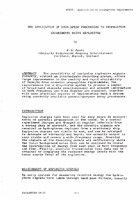| dc.contributor.author | Pyett, J. S. | |
| dc.date.accessioned | 2018-10-11T14:05:00Z | |
| dc.date.available | 2018-10-11T14:05:00Z | |
| dc.date.issued | 1979/12 | |
| dc.identifier | 503 | |
| dc.identifier.govdoc | CP-25/1 | |
| dc.identifier.uri | http://hdl.handle.net/20.500.12489/39 | |
| dc.description.abstract | The possibility of analysing explosive signals directly, without an intermediate recording system, offers large improvement~ in the quality and rapid availability of results from acoustic propagation experiments. The requirements for a ship-borne system to process a number of broad-band channels simultaneously and present information in both frequency and time domains are examined, together with some practical aspects of implementing such a system using currently available general-purpose array processors. | |
| dc.format | 5 p. : ill. ; digital, PDF file | |
| dc.language | English | |
| dc.publisher | NATO. SACLANTCEN | |
| dc.source | In: Real-time, general purpose, high-speed signal processing systems for underwater research (SACLANTCEN Conference Proceedings CP-25), Part 1, 1979, pp. 6-1 - 6-5. | |
| dc.subject | Underwater explosions | |
| dc.subject | Explosive sound sources | |
| dc.subject | Acoustic propagation | |
| dc.subject | Signal processing | |
| dc.subject | Sonar arrays | |
| dc.subject | Computer systems | |
| dc.title | The application of high-speed processors to propagation experiments using explosives | |
| dc.type | Papers and Articles | |
| dc.type | Conference Proceedings (CP) | |
